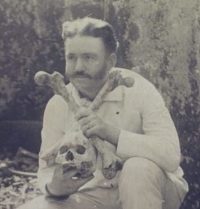San Roque, Luzon Island –Entry made in parlor of No. 2 Calle Santa Elena, Manila.
Up early, cooked breakfast washed dishes, then with Rev. & Mrs. Chas. Owens struck out on foot to walk down to the Cavite ferry near the Port Captain’s office. We were late. Took a “milord” (barouche) & reached the boat after the gangplanks had been pulled on the boat. They were put ashore again specially to take us on.
Reached Cavite about 10.15 a.m. Visited the arsenal and navy yard. Down there I secured from Joseph T. Davidson, A.A.A.G. of 51st Iowa’s permission to visit San Roque — got a pass– with my 2 companions. Wheeled vehicles have about all disappeared from Cavite. We walked over to San Roque. Passed the American sentry without showing the pass. The corporal in charge said it was unnecessary as he knew me.
A few houses remain in San Roque, but the whole town as a rule is in ashes & is depopulated. Domestic animals are without masters. About 200 dogs were shot by the American troops. Reason: fear that they will go mad from starvation specially thirst. The appearance of San Roque I shall not soon forget. The Filipinos fired the town before retreating. The uncaring of the people was manifested in a peculiar manner. The soil is a loose black and filled with sea shells. In this excavations were made –mostly under the houses, but in some cases, alongside. The shacks were set fire to, & the buried goods covered over, first with soil, then ashes which hid the place, but the scheme did not work. Quantities of household goods were exhumed & overhauled, & the ashes littered with miscellaneous articles: books, MSS, pictures, dresses, glassware, crockers, pillows, tools etc. etc. etc. stowed in chests, wardrobes & other furniture. I took several snapshots, one of several American soldiers bringing to Cavite a cart load of furniture, including a large mirror.
The sun was very hot. Returning from San Roque we took dinner at 3.15 p.m. in the United States Restaurant. Left Cavite for Manila on the 4 p.m. ferry boat.
Arriving in Manila Rev. Owens received a quilez. We drove to the post office & several stores for mail & groceries. I rec’d a small package with 2 Jan’y ’99 “Harbor Lights,” 2 “Local Officers” several children’s papers & no War Crys from New York. The most important thing rec’d was a personal letter from Lt-Col. Alice Lewis, New York. She answers my letters of 3, 10 & 19th (Dec presumably) date of her letter Jan’y 3d ’99. She says the Commander (Booth-Tucker) is communicating with London re the disposal of the Philippine Islands, but matters must or will remain stationary until settled. Don’t know when I am to return, but wants me to send cost of journey, route etc. so the Commander will have exact information, then he can send me explicit directions what to do.
Cooked supper. While eating it, Brother A.E. Temple of the 2d Reserve Hospital, Malate came in. We had a spiritual & other (subject) talk & prayer. He brought of me (20 cts Mex) 2 Tagalog gospels to give away. I also advanced him on credit to sell 10 copies each of St Luke & St. Mark in Tagalog to sell to Filipinos. Also gave him for free distribution: S.F. War Crys: 1 copy No. 573; 17 cop’s 575 & 14 cop’s 577. & 3 Chinese War Crys, No. 13, May 1897. Also gave him to distribute 10 copies “El Evangelista” –Spanish.
During my absence Bro. Green of B. Battery Utah artillery, brought me for a present of the 1 of the [illegible] Filipino daggers (lately captured) made to slay Americans.
Washed dishes after supper.
No serious fighting today — Temple said by yesterday American casualties were: 76 killed, 243 wounded.
In regard to the burning of San Roque I heard a lieutenant & some of the private of the 51st Iowa vol. inf. say they only had a chance to shoot one or two natives for the crime. They advanced the theory that short pieces of candles were left burning with the bottom resting in inflammable material, which caught fire when the candle burnt down & set the house in flames not a difficult matter when we consider the flimsy character of huts constructed of bamboo and nipa thatch.
